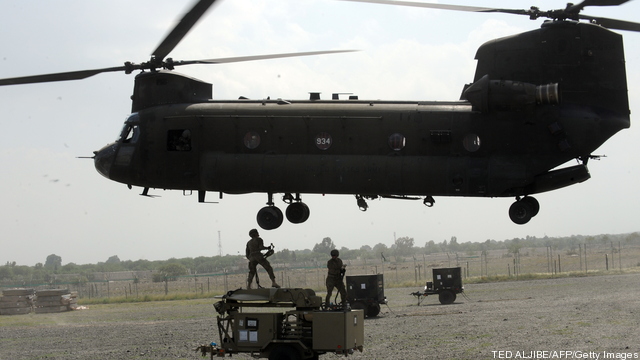 Philadelphia: The CH-47 Chinook helicopter has been flying U.S. soldiers, sailors, airmen and Marines into some of the world’s most dangerous places for over 50 years.
Philadelphia: The CH-47 Chinook helicopter has been flying U.S. soldiers, sailors, airmen and Marines into some of the world’s most dangerous places for over 50 years.
Now, a new program office will ensure that the venerable aircraft will still be able to fly those missions for another 50 years, the Army Colonel in charge of the effort said today.
The new office, which is part of Army Aviation and Missile Command at Redstone Arsenal, AL, was created last month to look at what upgrades would be needed to keep the Chinook combat-ready into the future, Col. Bob Marion, program manager for Army cargo helicopters, said yesterday.
Those upgrades, which include improving the helicopter’s armor and other protective measures, are currently focused on the Army’s latest versions of the Boeing-built Chinook, Marion told reporters here shortly after a ceremony commemorating the aircraft’s 50th anniversary.
Flanked by unfinished Chinook fuselages being assembled by Boeing at their factory here, Marion explained the long-term focus of the new office would be to figure out what capabilities will be needed for the H-model, or the next-generation of the Chinook fleet.
The CH-47F is the newest version of the aircraft being flown by the Army. The MH-47G is the version flown by special operations forces.
While many of the modifications for the Army’s F-model Chinooks will probably find their way into H versions, the office is still trying to figure out what other upgrades those new Chinooks will need in the future.
Another question the office, and the rest of the Army aviation leadership are wrestling with is how long can the service afford to keep the Vietnam-era helicopter in the fleet.
Maj. Gen. Tim Crosby, head of the Army’s aviation office, said the service is giving some serious consideration to what it will do once the Chinook comes out of the arsenal.
But that said, the two-star general said any decision on what kind of new helicopter would replace the Chinook once its time ran out was still years down the road. On average, each new Chinook variant has a 20-year life span from the day it rolls off the production line.
With the new F-models just getting into the hands of Army aviators this year, the soonest service officials will have to decide on a Chinook replacement would be 2020, Crosby said.
But recent history will not be on the Army’s side, if the service decided to move forward with a new helicopter to replace the Chinook.
The Army abandoned its Comanche attack helicopter program and the Armed Reconnaissance Helicopter effort in recent years. It is also just getting back up to speed on its Armed Aerial Scout helicopter program, which Crosby has put among his top budget priorities.
While the Army air chief said he was confident his office would get most of what it needs for the upcoming fiscal year, there are no guarantees that kind of DoD support will continue in the future.
In fact, with budgets across the Pentagon set to drop off over the next ten years, there is no guarantee Crosby’s office will have enough resources to keep the aircraft it has now airworthy.
(Full disclosure: Boeing paid for Carlo’s train ride to and from Philadelphia.)
‘AI-BOM’ bombs: Army backs off, will demand less detailed data from AI vendors
Instead of demanding an exhaustive “AI Bill of Materials.” the Army will only ask contractors for a “baseball card” of key stats on their AI — while building up its in-house capacity to check for bad code or “poisoned” data.



























